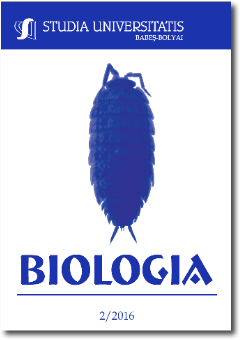Lycopene and Phycocyanin - biological properties in experimental diabetes: 1. Effects on blood parameters and liver carbohydrates
Keywords:
Arthrospira powder, diabetes, lycopene, oxidative stress.Abstract
Type 2 diabetes is one of the fastest rising metabolic diseases of our time, mainly due to an unhealthy lifestyle, diet and lack of exercise. While medical treatment does indeed exist and the quality of life is improved under medication, one must take into account that the predominant geographical areas in which diabetes is on the rise are underdeveloped and as such, access to modern medicine may be hindered. The purpose of our study was to confirm the hypoglycemic and antioxidant effects of two biomolecules in the pathology of diabetes. For this study we used 40 albino male Wistar rats, divided into four groups. The control group (C) received a normal diet and tap water. The untreated diabetic group (D) was intravenously injected with a dose of 50mg/kg streptozotocin after a 12 hour fasting period and given a normal diet and water. Diabetes was induced in the same way for the two treated groups, with their diets being supplemented with 10 mg/kg lycopene (DL group) and an equivalent of 200 mg/kg phycocyanin in the form of Arthrospira powder (DS group). Blood was drawn every 7 days do determine glycemic status and after 14 days the animals were killed under anesthesia, with blood and liver being collected for morphological and biochemical analysis. Blood glucose significantly dropped in the DL group on the 7th day of treatment, with both treatments reducing fasting blood sugar to normal levels on the 14th day. Hepatic glucose was normalized in both DL and DS groups without any significant change in glycogen concentrations. RBC counts revealed a tendency of the erythrocytes to increase in numbers in the treated groups and lycopene appears to restore WBC numbers to normal levels. Taking into account these results, it can be said that both biomolecules have a potent hypoglycemic effect in diabetic hyperglycemia, while also improving carbohydrate metabolism in the liver. Lycopene seems to be the more effective antioxidant of the two, preventing oxidative-induced hemolysis of the red blood cells and restoring normal PCV and hemoglobin levels.
References
Ali, M. M., Agha, F. G. (2009) Amelioration of streptozotocin-induced diabetes mellitus, oxidative stress and dyslipidemia in rats by tomato extract lycopene, Scandinavian Journal of Clinical and Laboratory Investigation 69(3), 371–379
Arab, L., Steck, S. (2000) Lycopene and cardiovascular disease, The American Journal of Clinical Nutrition 71(Supplement), 1691–1695
Basu, A., Imrhan, V. (2007) Tomatoes versus lycopene in oxidative stress and carcinogenesis: conclusions from clinical trials, European Journal of Clinical Nutrition 61(3), 295–303
Bayramoglu, A., Bayramoglu, G., Senturk, H. (2013) Lycopene partially reverses symptoms of diabetes in rats with streptozotocin-induced diabetes, Journal of Medicinal Food 16(2), 128–132
Chisté, R. C., Freitas, M., Mercadante, A. Z., Fernandes, E. (2014) Carotenoids are Effective Inhibitors of in vitro Hemolysis of Human Erythrocytes, as Determined by a Practical and Optimized Cellular Antioxidant Assay, Journal of Food Science 79(9), 1841–1847
Drabkin, D. L., Austin, J. H. (1935) Spectrophotometric studies. II. Preparations from washed blood cells; nitric oxide, hemoglobin and sulfhemoglobin, Journal of Biological Chemistry 112, 51
Eze, E. D., Tanko, Y., Tende, J. A., Ehinomhen, U. A. (2016) Effects of Lycopene on Liver Markers and Glucokinase Activity in Experimentally-induced Diabetes Mellitus Rat Model, Journal of Basic and Applied Research 2(3), 353–362
Farouk, K. E., Hanan, F. A., El-Sayed, A. B., Amal, A. M. (2013) Role of Spirulina Platensis in the control of glycemia in DM2 rats, International Journal of Scientific & Engineering Research 4(12), 1731–1740
Guo, Y., Liu, Y., Wang, Y. (2015) Beneficial effect of lycopene on anti-diabetic nephropathy through diminishing inflammatory response and oxidative stress, Food and Function 6(4), 1150–1156
Holzapfel, N. P., Holzapfel, B. M., Champ, S., Feldthusen, J., Clements, J., Hutmacher, D. W. (2013) The potential role of lycopene for the prevention and therapy of prostate cancer: From molecular mechanisms to clinical evidence, International Journal of Molecular Sciences 14(7), 14620–14646
Ip, B. C., Hu, K. Q., Liu, C., Smith, D. E., Obin, M. S., Ausman, L. M., Wang, X. D. (2013) Lycopene metabolite, apo-10′-lycopenoic acid, inhibits diethylnitrosamine-initiated, high fat diet-promoted hepatic inflammation and tumorigenesis in mice, Cancer Prevention Research 6(12), 1304–1316
Khan, Z., Bhadouria, P., Bisen, P. S. (2005) Nutritional and Therapeutic Potential of Spirulina, Current Pharmaceutical Biotechnology 6, 373-379
Layam, A., Reddy, C. (2006) Antidiabetic Property of Spirulina, Diabetologia Croatica, 62(1), 29-33
Lo, S., Russel, J. C., Taylor, A. W. (1970) Determination of glycogen in small tissue samples, Journal of Applied Physiology 28, 234-236
Luo, C., Wu, X. G. (2011) Lycopene enhances antioxidant enzyme activities and immunity function in N-methyl-N-nitro-N-nitrosoguanidine-induced gastric cancer rats, International Journal of Molecular Sciences 12(5), 3340–3351
Milaðius, K., Peèiukonienë, M., Dadelienë, R. (2004) Effect of Spirulina Food Supplement on Blood Morphological and Biochemical Composition in Sportsmen, Acta Medica Lituanica 11(1) 47-51
Montgomery, R. (1957) Determination of glycogen, Archives of Biochemical Biophysics 67 (2), 378-386
Nelson, N. (1944) A photometric adaptation of the Somogy method for the determination of glucose, Journal of Biological Chemistry 153, 375-380
Romay, C., González, R. (2000) Phycocyanin is an Antioxidant Protector of Human Erythroytes Against Lysis by Peroxyl Radicals, Journal of Pharmacy and Pharmacology 52(4), 367-368
Stankova, K., Ivanova, K., Nikolov, V., Minkova, K., Gigova, L., Georgieva, R., Boteva, R. (2011) The Biliprotein C-Phycocyanin Modulates the DNA Damage Response in Lymphocytes from Nuclear Power Plant Workers, Nuclear Power - Operation, Safety and Environment, Tsvetkov, P. (ed.), InTech, 327-340
Xiu, F., Stanojcic, M., Diao, L., Jeschke, M. G. (2014) Stress hyperglycemia, insulin treatment, and innate immune cells, International Journal of Endocrinology, 2014: 486403, http://dx.doi.org/10.1155/2014/486403
Zhou, P., Liu, L., Chen, X. (2005) Factors that affect antioxidant activity of C-Phycocyanins from Spirulina platensis, Journal of Food Biochemistry 76(2), 313-322
*** (2016) World Health Organization, Global Report on Diabetes, 88
Downloads
Published
How to Cite
Issue
Section
License
Copyright (c) 2016 Studia Universitatis Babeș-Bolyai Biologia

This work is licensed under a Creative Commons Attribution-NonCommercial-NoDerivatives 4.0 International License.





